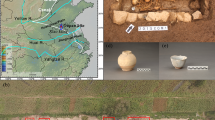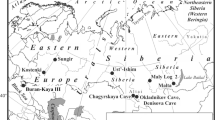Abstract
Palaeodietary analysis is one of important topics in bioarchaeology field and has been paid great attention to by Chinese archaeometrists recently. Ancient human bones in Jiahu Site were analyzed by means of stable isotopes of C, N and O. 13 human bones were excluded from 28 bones for dietary reconstruction due to their unusual collagen contents, C and N contents, and C/N atomic ratios especially. δ 13C (−20.37±0.53‰) in collagen of remaining samples showed that C3 food were consumed mainly, which is consistent of the archaeological findings that rice was the staple in Jiahu. According to the difference of δ 15N and δ 13C values in bone collagen, the samples can be classified into four clusters. The changes of δ 15N values in bone collagen and δ 13C values in hydroxylapatite through whole cultural phases indicated the transition from hunting to gathering and fishing to rice agriculture and animal domestication ultimately. Meanwhile, the δ 18O change in hydroxylapatite showed that palaeoclimate was relatively constant during Jiahu culture.
Similar content being viewed by others
References
Hu Y W, Yang X M, Wang C S. Review on ancient diet. In: Wang C, Zuo J, eds. Proceedings of Archaeometry, 2nd ed. (in Chinese). Hefei: University of Science and Technology of China Press, 2000. 51–58
Zhang X L. Application of elemental and isotopic analyses on ancient diet. Acta Anthropol Sin (in Chinese), 2003, 22: 75–85
White C D. Reconstructing ancient Maya diet. Salt Lake City: University of Utah Press, 1999
Cai L Z, Qiu S H. Measurement of C-13 and palaeodietary study. Archaeology (in Chinese), 1984, 10: 945–955
Zhang X L, Cai L Z, Qin S H, et al. Studies on ancient diet. Archaeology (in Chinese), 2003, 2: 62–76
Zhang J. Wuyang Jiahu. Beijing: Science Press, 1999
Zhang J, Harbottle G, Wang C, et al. Oldest playable musical instrument found at Jiahu, early Neolithic site in China. Nature, 1999. 366–368
Li X, Harbottle G, Zhang J, et al. The earliest writing? Sign use in the seventh millennium BC at Jiahu, Henan Province, China. Antiquity, 2003, 77: 31–44
Sheng T H, Wang J Y, Zhao B T. Biochemistry. 2nd ed. Beijing: Higher Education Press, 1995. 142–145
Zheng S H, Zheng S C, Mo Z C. Stable Isotopic Geochemical Analysis. Beijing: Peking University Press, 1986. 76
Van der Merwe N J. Carbon isotopes, photosysthesis and archaeology. Am Sci, 1982, 70: 596–606
DeNiro M J, Epstein S. Influence of diet on the distribution of carbon isotopes in animals. Geochim Cosmochim Acta, 1978, 42: 495–506
Ambrose S H, Norr L. Isotopic composition of dietary protein and energy versus bone collagen and apatite: purified diet growth experiments. In: Lambert J B, Grupe G, eds. Molecular Archaeology of Prehistoric Human Bone. Berlin: Springer, 1993. 1–37
Tieszen L L, Fagre T. Effect of diet quality and composition on the isotopic composition of respiratory CO2, bone collagen, bioapatite and soft tissue experiments. In: Lambert J B, Grupe G, eds. Molecular Archaeology of Prehistoric Human Bone. Berlin: Springer, 1993. 121–155
Van der Merwe N J, Roosevelt A C, Vogel A C. Isotopic evidence for prehistoric subsistence change at Parmana, Veneznela. Nature, 1981, 292: 536–538
Ambrose S H, Katzenberg M A. Biogeochemical Approaches to Paleodietary Analysis. New York: Kluwer Academic/Plenum Publisher, 2000
Bryant J D, Froelich P N. A model of oxygen isotope fractionation in body water of large mammals. Geochim Cosmochim Acta, 1995, 59: 4523–4537
Price T D, Blitz J, Burton J H. Diagenesis in prehistoric bone: problems and solutions. J Archaeo Sci, 1992, 19: 513–530
Hu Y, Wang C, Zuo J, et al. XRD and Raman spectra of hydroxylapatite in ancient bones. Acta Biophys Sin (in Chinese), 2001, 17: 621–627
Ambrose S H, Butler B M, Hanson D H, et al. Stable isotopic analysis of human diet in the Marianas Archipelago, Western Pacific. Am J Phys Anthropol, 1997, 104: 343–361
Ambrose S H. Preparation and characterization bone and tooth collagen for stable carbon and nitrogen isotope analysis. J Archaeo Sci, 1990, 17: 431–451
Hu Y W, Burton J H, Wang C S. Elemental analysis of human bones in Jiahu site. Acta Anthropol Sin (in Chinese), 2005, 24: 158–165
Author information
Authors and Affiliations
Corresponding author
Additional information
Supported by the Knowledge Innovation Project of CAS (KJCX3.SYW.N12), the National Science Foundation (40343021), the Wenner-Gren Foundation, Youth Funding of USTC, Fund of President of Graduate University of CAS, and the Starting Funding for Returnee of Ministry of Education
Rights and permissions
About this article
Cite this article
Hu, Y., Ambrose, S.H. & Wang, C. Stable isotopic analysis on ancient human bones in Jiahu site. SCI CHINA SER D 50, 563–570 (2007). https://doi.org/10.1007/s11430-007-2030-4
Received:
Accepted:
Issue Date:
DOI: https://doi.org/10.1007/s11430-007-2030-4




